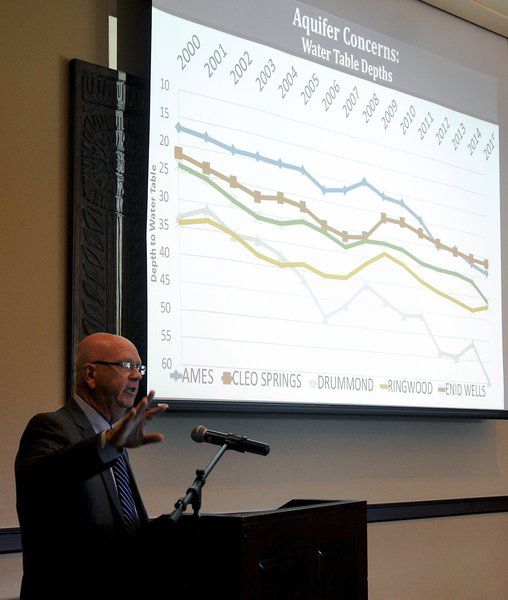When Ernie Currier was asked to head Enid’s water campaign, he said he spent several weeks before making his decision.
At Enid Regional Development Alliance’s annual meeting and quarterly luncheon Thursday, Currier released details regarding the city of Enid’s Kaw Lake Water Supply Project.
The city is proposing voters approve an increase in the sales tax by three-quarter percent and a continuance of a quarter percent sales tax to help fund construction of a pipeline from Kaw Lake to Enid.
“I can tell you I was one of those people that was probably between cynical and rabidly opposed to this because all I heard from when I was on the city commission for years was these folks back in 1980 did a great job preparing us for the future,” Currier said.
Currier is referencing a water project approved in 1980 that expanded pipeline into water fields west of the city. He said now, that pipeline and the aquifer feeding city wells are not enough. The city researched water options before choosing the Kaw Lake pipeline.
The project includes the construction of a 70-mile pipeline from Kaw Lake to the city, along with the construction costs of storage, water treatment facilities and engineering.
Currier said the median household income in Enid is $44,266. He said folks spend about 18 percent of their income on taxable goods. Based on the average median household income, that totals about $8,000 per person.
“We have a tax rolling off in 2018, and we want to continue that,” he said. “We’re asking that three-quarters of a cent on an annual basis, which per household is $60. This is to ensure we have water for the future, ensure your grandkids, your neighbor’s kids, the young folks have water. By the time this is all paid for, Ernie probably won’t be drinking much, but I want them to have water. I want them to have a surplus, and abundance of the resources they need to have a great life 20 or 30 years down the road.”
The city’s capital fund will not be used for the pipeline, Currier said. He stated the penny tax for street improvements and other capital improvements will continue to be used for such.
“By doing this as a tax, it keeps the water rates lower than if we don’t,” Currier said. “If we don’t pass this tax, I will tell you this — you’d probably rather pay $60 per year in additional taxes instead of $60 per month in an additional water bill. I’m not making a threat, but the problem is we have to go after water and we have to pay for it somehow. It’s a fact of life.”
Currier said he won’t get to vote on the issue on Aug. 23 but he will still pay the sales tax.
“This is something we need for our community, but the cool thing is that Northwest Oklahoma is going to help us pay for it,” he said.
Currier said cities all over the nation struggle to find viable sources of water and Northwest Oklahoma is no different.
“Our economy needs water to survive,” he said. “The Enid well fields (aquifer) — those fields closest to Enid that are easiest to get water from — we’ve seen a 17-feet decline since 2000. What we do is we measure where the water is from the top of the well, how far down do we have to go to pump this out. Our average well depth is 80 feet. In the Enid well field alone, you’ve seen a 17-feet decline since 2000. There is definitely a need we need to address.”
Currier said Enid gets water from several areas, including fields in Ames, Cleo Springs, Drummond, Ringwood and Enid. He said the Drummond well field is the one experiencing the most struggles.
“The Ames field, which is our best field, it’s my understanding that it has the best wells, the best water and it’s our baby — the Ames field in the same period 15-year period has declined 17 feet. Cleo Springs has declined 9 feet. Ringwood has held the steadiest with a 7-foot decline, but the trend is still declining. Drummond has declined the most at 26 feet. The average decline per field is 15.2 feet.”
Declines are important because you can’t pump to the bottom of a well unless you want to just get dirt, Currier said.
Regardless of Thursday’s rain, Currier said Oklahoma still is in a drought. The wettest part of the past century was late 1990s to early 2000s, he said.
“So it’s not just drought,” he said. “The wells are just declining even in the wettest part of history. The aquifers don’t just belong to us, but the oil field uses them, farmers, other communities — they all draw water from the field.”
Along with decreasing well levels, Enid has seen an increase in nitrate levels. The city blends water sources to improve nitrate levels, and the water still meets standards, Currier said.
Why not drill more wells, he asked.
“You could produce more water immediately ,but then there’s a steeper decline and water comes out quicker,” he said, adding it’s like having everyone put a straw into one cup of water. “It (the wells) is our only source of water and we have maintained it.”
For more information, or to ask questions, email yesenidwater@gmail.com or YesEnidWater on Facebook.
Story by Enid News and Eagle
Written by Emily Summars


